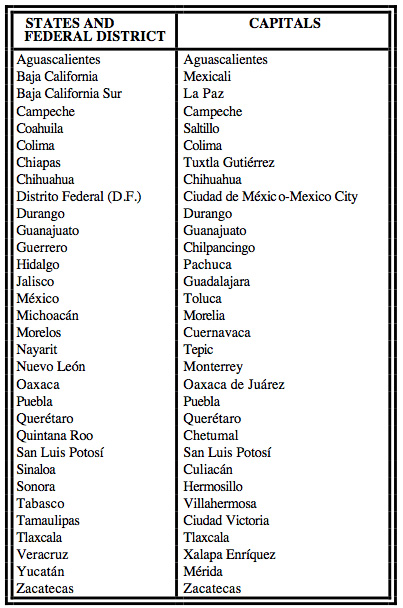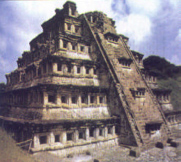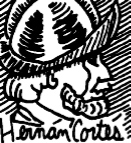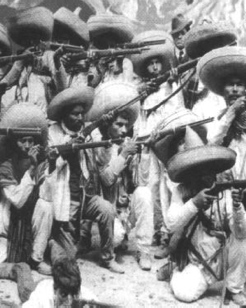Mexican Geography and People
The official name for Mexico is United Mexican States. It is bordered on the north by the United States, on the southeast by Guatemala and Belize, on the east by the Caribbean and the Gulf of Mexico, and on the west by the Pacific Ocean.
With a population of more than 100 million, Mexico is the largest Spanish-speaking country in the world. The capital, Mexico City, is not only the nation’s most populous city, but with more than 25 million inhabitants the largest metropolitan area in the world. Much of the explosive growth of Mexico City and other major population centers, such as Guadalajara, Monterrey, Puebla, León, Ciudad Juárez, and Tijuana, is the result of rural-urban internal migration. Birth rates, once quite high, have declined, thanks in part to an aggressive family planning campaign by the federal government. The population is very young, with more than 50 percent under the age of 20 years old.

Approximately 55 percent of the population is mestizo, or mixed European and indigenous blood. About 29 percent are indigenous and 15 percent of European descent. Roman Catholics account for more than 92 percent, Protestants more than three percent, and other religions the remainder. In addition to Spanish, more than 60 languages are spoken. Among the most important are Nahuatl, Maya, Mixteco, and Zapoteco.
The political divisions of Mexico include 31 states and one federal district, called the D.F., for Distrito Federal. Mexico is a federal republic governed in accordance with the Constitution of 1917. There are three branches of government: the executive, the legislative, and the judiciary.
The president is elected for a single, six-year term. The bicameral legislature is composed of the Senate, whose 64 members (two from each state and the Federal District) are elected for six-year terms, and a Federal Chamber of Deputies, which consists of 500 members who are elected to three year terms of office. The Mexican Supreme Court consists of 21 members who are appointed by the president with the consent of the Senate. Other judicial bodies include district and circuit courts.
The three most important political parties, which are commonly referred to by their acronyms, are the PAN (National Action Party-Partido de Acción Nacional), the PRI (Institutional Revolutionary Party-Partido Revolucionario Institucional), and the PRD (Party of the Democratic Revolution-Partido de la Revolución Democrática). The PRI was formed in 1928 as an outcome of the Mexican Revolution and dominated Mexican politics until the late 1980’s. In the 2000 elections the PAN formed an alliance with the Green Ecological Party and won the presidency for the first time in 71 years. The more conservative PAN also controls a growing number of governorships. The more liberal PRD also has won some important positions, such as control of the government of Mexico City. Each state elects its governor, who serves a six-year term.
Mexican Districts and Capitals

The Land
Mexico is a large, mostly mountainous country. The dominant feature is an immense, elevated plateau, called the Altiplanicie Central, where more than half of the population lives in the states of Querétaro, Morelos, México, Michoacán, Jalisco, Guanajuato, Hidalgo, and Tlaxcala. It sits between two mountain ranges, the Sierra Madre Occidental in the west, and the Sierra Madre Oriental in the east. These ranges meet in the southeast to form the Sierra Madre del Sur, which forms a “formidable wall of volcanoes” (Calderwood and Breña p. 61) and includes the five highest peaks in Mexico. Among these are: Popocatépetl (17,887 ft.) and Iztaccíhuatl (17,671ft.) outside México City; Orizaba, located near Puebla and at 18,855 ft. the highest in Mexico; and Paricutín (9,101 ft.) in Michoacán, the youngest, having erupted in 1943. The Balsas River Basin, called Tierra Caliente and located in Michoacán and Guerrero, separates the volcanic zone from the mountain range called the Sierra Madre del Sur.
Calderwood and Breña have described the Central Plateau as the “cradle of politics, the birthplace of fine arts and Mexican cuisine.” It is here that hunters and gatherers discovered how to cultivate maize. It was the location of many of the great prehispanic centers, such as the huge urban center of Teotihuacan, and later of Tenochtitlán, now Mexico City and origin of the nation’s patriotic symbols. According to the same authors, many of the most important events in Mexico’s history occurred on the Central Plateaus including, “...short and violent episodes, such as the Conquest or the war for Independence, or long processes, such as the domestication of corn or the evolution of nationalism ” (p. 62).
The Sierra Madre del Sur extends to the Isthmus of Tehuantepec, which is the narrowest part of Mexico. A range called the Oaxacan highlands branches northward from Oaxaca and a narrow stretch of lowlands runs along the Pacific coast south to Guatemala. Inland, the Sierra Madre de Chiapas leads to the Chiapas highlands and farther northeast to the tropical rainforest called El Petén.
The Yucatan Peninsula is a flat, limestone formation, which includes tropical savanna and dry, desert-like conditions at its tip. It was in the southern and southeastern areas of Mexico and neighboring Guatemala that the Mixtec, Toltec, and Mayan civilizations flourished.
The coastal plains for the most part are flat and sandy. The features of Baja California, the longest peninsula in the world, include mountains, deserts, plains, and beaches.
"The land is tumultuous. Mexico is more mountainous than Montana and rises far higher than Colorado. In the north the landscape looks like Nevada and southern Arizona...sweltering broad desert valleys and long bareback mountains. Farther south the great lumpy highland of the central mesa rises amid multiple mountain ranges to lofty, cool valleys punctuated by volca-noes. South of that, the mountains tumble to the low, swampy Isthmus of Tehuantepec, beyond which more hills rise, clothed in rain forest" (Parfit p. 11).
Mexican Hydrography and Climate
The longest river is the Río Bravo del Norte, which forms the border with the United States. Other important rivers include the Balsas, Grijalva, Usumacinta, and the Conchos. Most rivers are not navigable. Lake Chapala, near Guadalajara, Jalisco, is the largest lake, but has been depleted in recent years because of pollution and providing water for Mexico City.
The Tropic of Cancer bisects Mexico just north of Mazatlán and Fresnillo. While it is hot and humid along the coastal plains of both coasts south of this line, this climate becomes increasingly arid towards the north. Other areas with hot temperatures include the Balsas River Basin (including Estado de México, Michoacán, and Guerrero) and the Chiapas Valley. Temperate and cool conditions are common in the Central Plateau, where, generally speaking, temperatures decrease with increasing altitude and mountain peaks are capped with snow.
The hot, rainy season lasts from May to October. The wettest areas are the coasts south of the Tropic of Cancer, the eastern slopes of the Sierra Madre Oriental, and the northern side of the Isthmus of Tehuantepec. The Central Plateau and semi-arid north receive much less rainfall.
Plant and Animal Life
Mexico is home to an impressive variety of plants and animals caused, in part, by the great climatological and geographical differences. This diversity includes rainforest vegetation in southwestern and southeastern Mexico, such as valuable hardwoods and oaks, pines, and firs on the mountain slopes. In the arid north and the dry areas of the Central Plateau, cactus, yucca, mesquite, and dry grasslands are common. Arctic vegetation exists at the high altitudes.
Animal life also is quite diverse in accordance with the climate and altitude of the habitat. For example, the volcano rabbit is found only on the slopes of Popocatépetl and Iztaccíhuatl. There is abundant bird life, from the exotic species of the jungles to the raptors that soar over the mountains. Other animals include wolves, coyotes, jaguars, bears, pumas, turtles, lizards, snakes, iguanas, ocelots, and tapirs.
Mexican History
The foundations of human life here go back to the time of geologic formation; some lava peaks are younger than the bloodlines of the people who live in their shadow (Parfit p. 11).
Evidence of nomadic hunters and gatherers dates from 20,000 to 10,000 BC, depending upon the source. The cultivation of crops, especially corn, was followed by the development of many civilizations. The first of these was the Olmec, who flourished on the tropical lowlands of the Gulf Coast between 1500 and 450 B.C.
The Zapotecs leveled a mountain and built Monte Albán, near Oaxaca, where they constructed pyramids, observatories, and tombs. They are known for their gold jewelry. The Mixtecs inhabited Monte Albán after the decline of the Zapotec civilization. They also built Mitla, a city whose buildings are decorated with geometrical designs comparable to the motifs typical of ancient Greece.
Teotihuacan , near Mexico City, may have been the largest city in the western world before the Spanish conquest. It was built by skillfully artistic and scientific people. The most famous remains are the gigantic pyramids of the Sun and the Moon. The Pyramid of the Sun is the largest in volume in the world. A warlike tribe called the Chichimec destroyed Teotihuacan in about 900 AD.
El Tajín was a great metropolitan center in the lowlands of eastern Mexico. The city is most famous for the unusual and advanced engineering concepts used for the construction of pyramids and temples. The Pyramid of the Niches, at right, has 365 window-like openings
Between 200 BC and 900 AD the Maya built one of the greatest civilizations of the Americas in what is now Honduras, Guatemala, and southern Mexico. They built great stone pyramids and temples and wrote on stone pillars as well as on paper. The Mayan sculptors carved beautiful objects from jade and wood. Potters made perfectly shaped bowls and vases.
The Mayan priests invented the number zero long before its use in Europe. They also studied the stars and developed an accurate calendar consisting of 18 months of 20 days each and one month of five days. The Maya calculated the length of the year at 365.2420 days.

The Toltecs have been called the “master builders of Mexico.” They founded their capital city at Tula, north of Mexico City, in the 9th century AD, and later reconstructed parts of the former Mayan center of Chichén Itza. Tula is where the famous Atlantes of Tula, huge figures of warriors that stand atop the pyramid of Quetzalcoatl, maintain their vigil.

The Aztecs, or Mexicas , provided Mexico’s name and patriotic symbols. Obeying what they believed to be the mandate of a deity, they founded on or about 1321 AD the city and ceremonial center of Tenochtitlán, where they came upon a serpent perched on a cactus eating a snake. The invading Spanish called Tenochtitlán the most beautiful city they had ever seen, because of its wide streets, aqueducts, bridges, and ceremonial pyramids. Today, it is called Mexico City.
 The Spanish conquest of Mexico, which began in 1519 when Hernán Cortés landed on the Gulf Coast, was nothing less than a brutal cultural encounter which led to 300 years of colonial domination. This protracted colonial period was characterized by exploitation of the indigenous population, establishment of the power and authority of the Roman Catholic Church, the creation of rigid social classes, and an often inefficient bureaucracy. These social and political patterns have continued to influence Mexican history.
The Spanish conquest of Mexico, which began in 1519 when Hernán Cortés landed on the Gulf Coast, was nothing less than a brutal cultural encounter which led to 300 years of colonial domination. This protracted colonial period was characterized by exploitation of the indigenous population, establishment of the power and authority of the Roman Catholic Church, the creation of rigid social classes, and an often inefficient bureaucracy. These social and political patterns have continued to influence Mexican history.
Mexico was considered the “most precious jewel” of the Spanish colonies because of its vast quantities of gold and silver, its access to shipping lanes to cross the Atlantic, and because it was the first and largest of the colonies. In Mexico City the Spanish established one of the first universities in the Americas in 1553 and the first printing press in 1539. They explored and colonized vast territories that today are part of the United States.
"The oppressive rule of the Spanish stamped Mexico with an imprint of European religion, agriculture, and industry, but unlike the colonists to the north the Spanish did not obliterate earlier races. Instead, the mixing of Spanish and Indian has created a people like no other on earth" (Parfit p. 11).
In 1810 Father Hidalgo’s call to arms, the Grito de Dolores (shout of Dolores) signaled the beginning of the struggle that eventually led to independence from Spain, but not to political or social stability. During the remainder of the century, Mexico suffered a civil war, conflict with the United States which resulted in the loss of much of its territory (the states of Arizona, California, Colorado, New Mexico, Nevada, Utah, and Texas), invasion and rule by the French, and three decades of dictatorship at the hands of Porfirio Díaz.
 This dictatorship ended in the lengthy, bloody Mexican Revolution, during which many suffered hunger and many others fled to the United States. Mexico was left in economic ruin and with its population reduced by more than a million.
Nevertheless, the Mexican Revolution achieved many goals. The Constitution of 1917 serves as the basis for Mexican life today. Agrarian reform restored land to
indigenous peoples and divided the great haciendas among the peasants.
This dictatorship ended in the lengthy, bloody Mexican Revolution, during which many suffered hunger and many others fled to the United States. Mexico was left in economic ruin and with its population reduced by more than a million.
Nevertheless, the Mexican Revolution achieved many goals. The Constitution of 1917 serves as the basis for Mexican life today. Agrarian reform restored land to
indigenous peoples and divided the great haciendas among the peasants.
The new Constitution also established minimum salaries, work hours, and conditions. The government expropriated all property belonging to the Roman Catholic Church. It established the one term presidency and gave birth to the Mexican political party called Institutional Revolutionary Party (PRI), which dominated Mexican politics until the late 1980’s, and controlled the presidency until the July, 2000.
According to the Mexican public school history textbook, Historia: cuarto grado, another type of battle was engaged during the government of Obregón from 1921 to 1924--the battle against illiteracy (SEP p. 162). The Secretary of Education, José Vasconcelos, worked vigorously to establish primary schools throughout Mexico, especially in rural and poor areas. He launched a literacy campaign, promoted the construction of technical schools, and sought to attend to the health problems of children. Vasconcelos also contributed to the arts by supporting painters such as the world renowned muralists Diego Rivera and José Clemente Orozco.
The educational crusade of Vasconcelos spread the message that the renewal of the country should be founded upon national values in concert with universal values. His works serve as an inspiration to all who serve as educators. The sweeping educational reform of 1992 and commitment to establish educational opportunities throughout Mexico have been achieved in this spirit.
In the years between the Revolution and World War II, Mexico nationalized the railroads and seized foreign-owned oil properties. During World War II, a number of trade and military agreements between the United States and Mexico were signed, and Mexico agreed to pay US oil companies for the confiscated properties.
Mexican industry is one of the most developed among the nations of the Americas, which represents a shift from an economy based on primary production toward becoming an industrialized country. In addition to being a major oil-producing nation, Mexico produces a number of industrial and consumer products. Guadalajara has become known as “Silicon Valley South,” as shiny new factories produce and assemble billions of dollars in high tech products.
Mexico does, however, face significant social, political, and economic problems. The Mexican textbook Historia: sexto grado identifies poverty, democracy, ecology, and balance in foreign relations as major challenges of contemporary Mexico (SEP 101). It also cites inequalities in incomes and standards of living between rural and urban areas as well as among the regions. Because of severe shortages of arable land in much of Mexico, rural to urban migration is a continuing phenomenon. These immigrants become the poorest inhabitants of the cities. Many immigrate to the United States seeking work.
In the past few years, because of NAFTA, the peso devaluation, the insurgency in Chiapas, Mexico’s economic and social challenges have received significant press coverage in the United States. Despite these problems and challenges, a National Geographic special edition, Emerging Mexico, concluded that the character of the Mexican people will serve her well. In the words of Michael Parfit, “… even in the choking sprawl of Mexico City, the timeless support of family, faith, music, and laughter creates a resilience that fears about the future cannot erode” (p. 4).
And Mexico has indeed Mexico fulfilled Parfit’s vision, tackling its most intransigent problems, such as runaway inflation. The government has implemented an impressive array of programs, vastly improving educational opportunities.